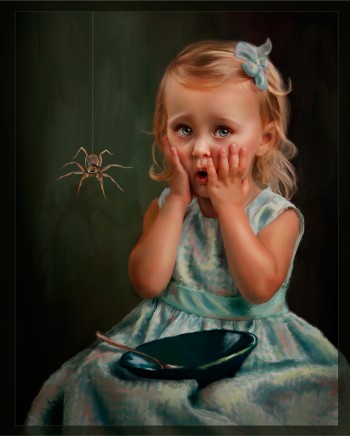Some of the greatest photography is accidental, or at least not pre-planned and posed. Such was the case with Little Miss Muffet, which won a LexJet Sunset Award, Best in Show and Best Portrait of a Child at the recent American Photographic Artists Guild (APAG) competition.
For Little Miss Muffet, it was less accidental and more what the winning photographer, Tracye Gibson, calls a “grab shot.”
“My camera was on a stand and my Pocket Wizard was in my hand. I was adjusting lighting while she was playing around and making silly faces. I knew the lighting wasn’t perfect and neither was the focus, but since I usually paint my images in Corel Painter anyway, I just kept snapping away while I was adjusting everything,” recalls Gibson. “When a good friend, who knows my style of work, saw the raw images, she said, ‘You have got to paint that as Little Miss Muffet!’ Sure enough, she was right.”
For the competition, the image was printed with her Epson Stylus Pro 7800 on LexJet Sunset Photo Gloss Paper 300g, laminated with a gloss laminate and applied to a foam board. Gibson says Sunset Photo Gloss shows up better in competition lighting and the blacks, color and contrast pop more.
“The style I use is more of an oil-painting look so it doesn’t work as well on matte or art papers. I plan to experiment with canvas at competition, because they’re going to allow that now and I’ll use a gloss coating in that case,” says Gibson. “I print a lot of my painted photography on canvas and hand-embellish it with acrylic, which is a lot of fun.”
Gibson says that the ability to print her own work helps alleviate any unwanted surprises.
When she first printed Little Miss Muffet she noticed that the shadow behind the spider had a lot banding because she used a Gaussian blur and lowered the opacity, which will sometimes cause unwanted banding.
“I couldn’t see it on the monitor, but once I printed it I saw it and I was so glad I print my own work. If I had sent it out, they probably wouldn’t have noticed it. The judges would be sure to notice it, however,” she says. “In competition I like to use an actual a print; a lot of people are now submitting their entries digitally and I think that’s a loss for the industry. Number one, you don’t want to sell digital files to a client, plus I feel like I have more control with a printed image, because you don’t know what kind of viewing conditions a digital file will be under.”
Little Miss Muffet obviously caught the judges’ eyes and any flaws that could have deducted points were caught by Gibson in the print proofing stage. And, like many award-winning photos, Little Miss Muffet tells a story.
“When I first painted the spider, for instance, it was too scary. I wanted it to look more like a storybook so I ended up painting a smiley face on it; the spider was still scary, but it gave it more an illustrative storybook feel to it,” explains Gibson. “Plus, my favorite images of kids are those where they’re not smiling big, cheeky smile. In Little Miss Muffet, she has a shocked look on her face, so it’s not the typical portrait.”



